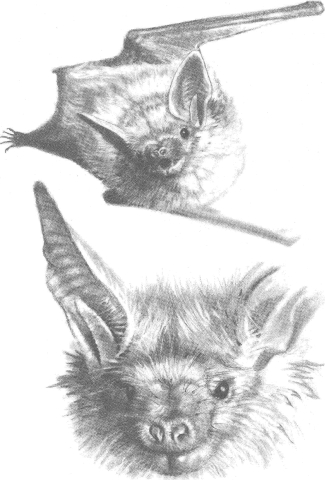The only breeding data for the British Columbian population are a nursing female and a male with enlarged testes, both captured on 9 August, which suggests that young are born in July. In the southwestern United States mating takes place from October to December. The gestation period is about nine weeks and young are born in May and June. The Pallid Bat usually bears one or two young, with twins most common; there are a few records of females carrying three or four foetuses. Females are capable of breeding in their first year but yearling females can bear only one young. The age of sexual maturity for males is unknown. Young weigh 3.0 to 3.5 grams at birth; they are undeveloped and their eyes are closed. In four or five weeks they are capable of flight and by eight weeks they attain adult size.
|
In summer this species is a late feeder leaving its day roost about 45 minutes after sunset. Pallid Bats may commute up to four kilometres between their day roosts and foraging areas. In British Columbia, this species seems to hunt mainly over tracts of open grassland sparsely covered with Big Sagebrush, Rabbit Brush and Bitter-brush. Gravel roads may provide foraging corridors - there are several observations of Pallid Bats flying low over roads in the Okanagan.
A large, powerful bat with robust teeth, this species is well adapted for killing and eating large invertebrates. It usually gleans prey from the ground and the foliage of trees and shrubs, but it occasionally pursues insects in the air. In the western United States the Pallid Bat eats june beetles, moths, cicadas, praying mantises, katydids, grasshoppers, scorpions and crickets. There are also records of this bat preying on small lizards and even a desert Pocket Mouse. Faecal pellets from the Okanagan Valley contained mostly beetles; moths and lacewings were minor prey items. While hunting, the Pallid Bat flies slowly, close to the ground, with rhythmic dips and rises. While hunting prey on the ground it listens for their rustling sounds; it will also forage in the foliage of trees and shrubs. Aerial prey are tracked with echolocation. The Pallid Bat eats small prey while it is flying, but takes larger items back to its night roost for consumption.
|
Little is known about its biology in the province, but it has been the subject of intensive study in the southwestern United States. Horizontal rock crevices with a hot, constant temperature (30°C) are the preferred summer day roosts, although it has also been found roosting in tree cavities, buildings, caves, mine adits and crevices in cliffs. A gregarious bat, most of the Pallid Bat's summer roosts comprise 20 to 200 individuals - the largest are maternity colonies. In some areas, males and females roost separately, but in others, mixed colonies containing both sexes have been found. The composition of colonies in British Columbia is unknown, but 14 of 19 Pallid Bats captured in the province were males, suggesting that the population may be predominately male. It appears that Pallid Bats frequently change the location of their day roost.
Night roosts are exposed sites near the day roost and are often conspicuous because of the presence of large accumulations of guano and discarded insect fragments. In British Columbia, this bat seems to prefer Ponderosa Pines for night roosts; in the United States, it also uses man-made structures, crevices and caves. After feeding, Pallid Bats form clusters at the night roost and if temperatures are cool they become torpid for several hours. Before returning to the day roost they may briefly feed again. Individuals found together at a night roost may occupy separate day roosts.
There are no winter records of Pallid Bats for the province. In the western United States this species is thought to overwinter in the general vicinity of its summer range. Hibernating Pallid Bats have been found in buildings, rock crevices, mine tunnels and caves. Most of these hibernating records are of one or a few individuals-large winter aggregations seem to be rare.
A social bat, this species produces an assortment of vocalizations for communicating in a colony. These calls, most of which are audible to humans, are used in territorial disputes, for directing individuals to a roosting site and in mother-infant communication. Newborns also emit calls that may assist mothers in locating them. Swarming and calling near roosting sites after the bats return from feeding are thought to advertise roost locations to other members of a colony.
The Pallid Bat produces a musky skunk-like odour from glands on the muzzle. There have been no experimental studies to determine the function of this odour - it may be a defensive mechanism for repelling predators.
|
|


